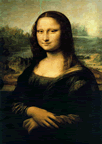
After studying fractions of the human form in the Vitruvian Man project, students will begin to understand one of the assumptions behind it - that bodies are symmetrical. In DaVinci's most famous painting, the Mona Lisa, details reveal that the background, as well as her face are not symmetrical. Art critics have implied that this is what has allowed the face of Mona Lisa to look so realistic and human and to become so famous throughout the past 500 years. Today beauty experts claim that beauty is based on proportions and exact symmetry. By investigating the symmetry of magazine models and more traditional beauties from paintings and the students themselves, students will have the opportunity to identify what "beauty" is and how this has changed over time.
Activities: The Beauty Mask (a closer look at faces and the Golden Ratio)

